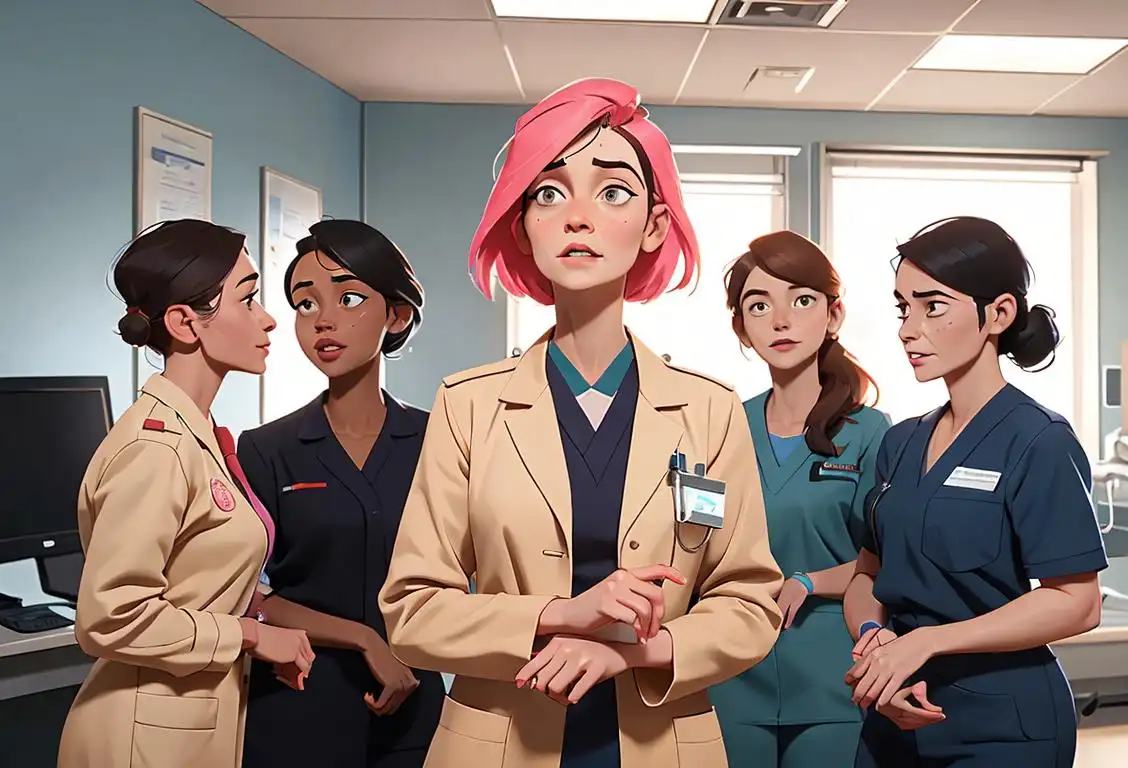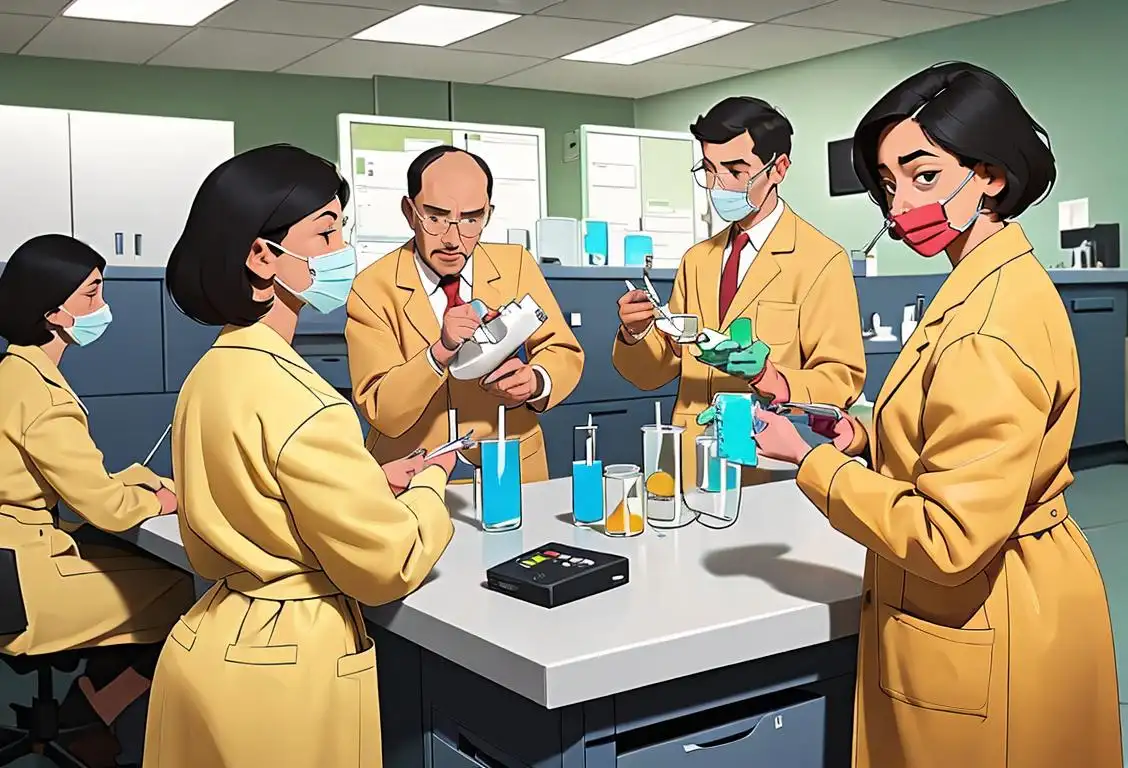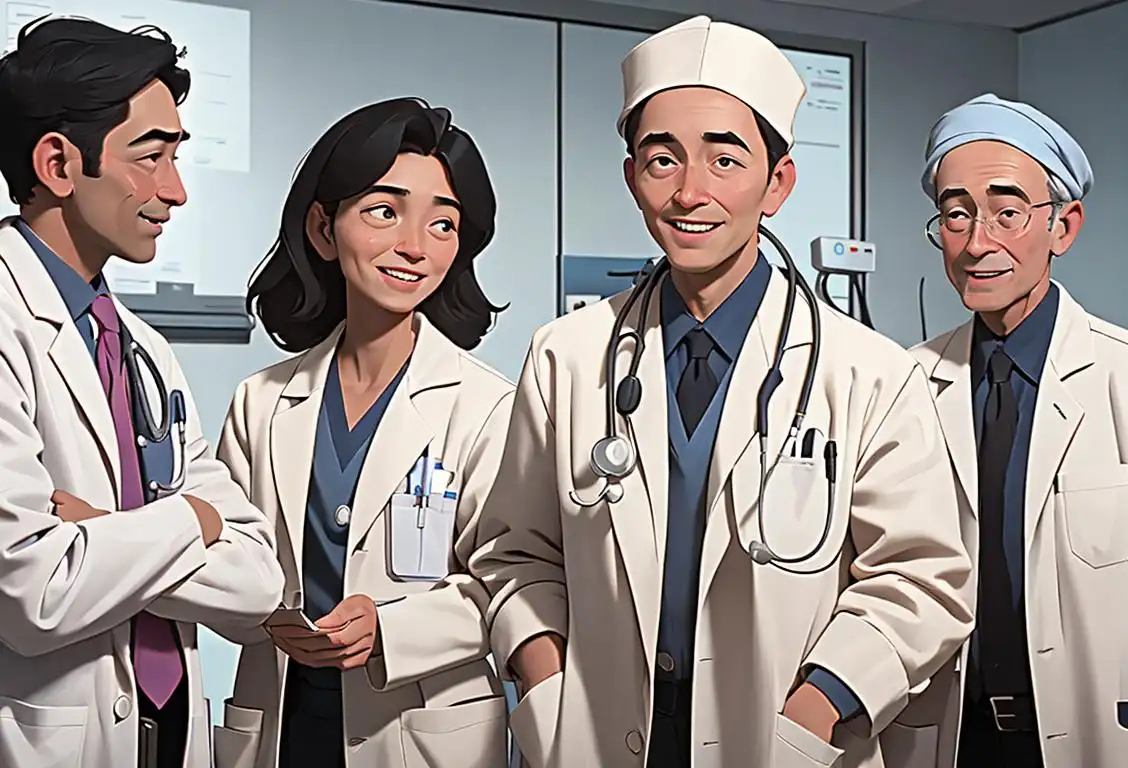National Allied Health Professionals Day

Hey there, health enthusiasts! Get ready to celebrate National Allied Health Professionals Day and give a big shoutout to all the amazing individuals who make a difference in the healthcare industry. This special day is all about showing appreciation for the hard work and dedication of allied health professionals. So, let's dive into the world of these unsung heroes and discover what makes this day so great!
When is Allied Health Professionals Day?
It's national allied health professionals day on the 14th October.
The Rise of Allied Health Professionals
Imagine a world without allied health professionals. It would be like trying to juggle chainsaws blindfolded - dangerous and near impossible! But luckily, we have these incredible individuals who are the backbone of the healthcare system, supporting doctors and nurses in their noble mission.
Allied health professionals encompass a wide range of healthcare roles, from occupational therapists and physiotherapists to radiographers and dietitians. These skilled experts work tirelessly to ensure our bodies are in tip-top condition, helping us recover from injuries, managing chronic conditions, and keeping us healthy.
A Day to Appreciate and Celebrate
On National Allied Health Professionals Day, we turn the spotlight on these unsung heroes and shower them with the praise they deserve. It's an opportunity for us to express our gratitude and appreciation for their dedication, professionalism, and expertise. Whether they're helping someone regain mobility after an accident or guiding patients towards a healthier lifestyle, allied health professionals make a real difference in people's lives every single day.
So, how can you celebrate this special day? Well, it's the perfect time to say a heartfelt 'thank you' to the allied health professionals you know. Send them a card, bake them some cookies, or simply give them a big virtual hug. Let them know that their work does not go unnoticed!
A Fun Fact to Impress Your Friends
Did you know that the term 'allied health' was coined in the 1930s in response to the growing need for healthcare professionals who were not doctors or nurses? It was a way to recognize and categorize the various roles that play a vital part in patient care. Pretty cool, right?
History behind the term 'Allied Health Professionals'
1917
The Birth of Allied Health Professionals
The term 'allied health professionals' was first coined in 1917 by the U.S. Army during World War I. As part of the war effort, the Army established the Medical Department of the U.S. Army to oversee the healthcare needs of soldiers. The term was introduced to refer to a group of medical professionals who supported and complemented the work of physicians and nurses.
1930
Origins of Allied Health
The term 'allied health' was first used in the 1930s to describe a group of healthcare professions that were distinct from medicine, nursing, and pharmacy. These professions were considered to be essential in supporting patient care, but they did not fall under the traditional categorization. Some of the earliest allied health professions included physical therapy, occupational therapy, and medical laboratory technology.
1956
Creation of the term
The term 'allied health professionals' was first coined in 1956 to describe a group of healthcare workers who are not doctors, nurses, or pharmacists. It was created to encompass a wide range of professions that support and work alongside physicians and nurses in patient care. This new term was necessary to acknowledge the growing number of healthcare professionals who play critical roles in the healthcare system.
1908
Formation of the Medical Department
In 1908, the Medical Department was established by the United States Army. This department focused on providing medical care for soldiers and their families. The department consisted of various healthcare professionals including dentists, nurses, and pharmacists.
1914
Formation of the National League of Nursing
In the year 1914, the National League of Nursing (NLN) was established, aiming to improve the quality of nursing education and the healthcare profession as a whole. This marked the beginning of a concerted effort to elevate the status of healthcare professionals and recognize their crucial role in the field.
1919
Emergence of the concept
The term 'allied health professionals' first emerged in 1919 when the American Hospital Association started using it to define a group of health workers who were not physicians, nurses, or dentists. These professionals were considered to be part of a broader healthcare team that supported the main medical staff.
1919
Emergence of Allied Health Services
In 1919, after World War I, the need for medical care and rehabilitation for soldiers returning from battle prompted the development of various medical disciplines. These new disciplines were created to support and work alongside the physicians and nurses, forming a group known as allied health services. The core objective was to provide essential healthcare services that were complementary to the traditional medical model.
1917
Emergence of Medical Social Work
In 1917, medical social work began to emerge as a profession. The term 'allied health professionals' did not yet exist, but this period marked the beginning of healthcare professionals working alongside physicians and nurses to provide holistic patient care. Medical social workers focused on the social and emotional aspects of health, working in hospitals to address patients' psychosocial needs and facilitate their recovery.
1860
Emergence of the term 'allied health'
The term 'allied health' first emerged in the mid-19th century. In 1860, the American Nurses Association coined the phrase to refer to a group of healthcare professionals who were not physicians or nurses but played a vital role in patient care. This included medical laboratory technicians, radiographers, and technicians skilled in various diagnostic procedures.
1926
Introduction of Occupational Therapy
Occupational therapy was officially introduced as a discipline in 1926. Professionals in this field specialized in assisting individuals with physical or mental disabilities to regain independence and improve their overall well-being through purposeful activities. The addition of occupational therapy expanded the scope of allied health professionals, highlighting the importance of holistic care.
1914
Expanding the Healthcare Team
In 1914, the concept of expanding the healthcare team emerged as the Medical Department recognized the need for specialized professionals to support medical practitioners. This led to the inclusion of new roles such as medical laboratory technicians and radiographers.
1934
First Allied Health Profession
The year 1934 was significant in the history of allied health professionals as the American Medical Association (AMA) recognized the first official allied health profession - Medical Technology. Medical technologists, also known as medical laboratory scientists, play a crucial role in diagnosing diseases, conducting tests, and analyzing patient samples in laboratory settings. This recognition set the stage for the expansion of allied health professionals in the coming years.
1960s
Expansion of allied health professions
During the 1960s, the field of allied health professions experienced significant growth and diversification. Various new professional roles emerged, including medical technologists, physical therapists, occupational therapists, dental hygienists, and speech-language pathologists. The term 'allied health professionals' became widely recognized and accepted, referring to this expanding group of specialized healthcare workers.
1942
Military-Based Expansion
During World War II, there was a significant expansion of the allied health workforce. The military recognized the need for a wide range of healthcare professionals to support the injured soldiers. This led to the establishment of specialized training programs for allied health professionals, such as radiographers, respiratory therapists, and dental hygienists. This period of military-based expansion helped solidify the importance of allied health within the healthcare system.
1930s
Recognition and Standardization
In the 1930s, the allied health professions gained recognition and began to be standardized. As medical knowledge expanded and specialized fields emerged, the need for a wider range of healthcare professionals became evident. This led to the recognition and classification of various allied health professions such as medical technologists, radiographers, dietitians, and physical therapists.
1923
Formation of the National Association of Science Teachers (NAST)
In 1923, the National Association of Science Teachers (NAST) was established, aiming to promote and improve science education. As part of their efforts, NAST recognized the importance of allied health professions and included them in their science curricula. This recognition contributed to the growing acceptance and acknowledgment of these professionals as integral members of the healthcare team.
1967
Creation of the first allied health organization
In 1967, the American Association of Medical Assistants (AAMA) was established as the first national organization dedicated to promoting and supporting allied health professionals. This marked a significant milestone in recognizing the importance of these healthcare workers and fostering their professional development.
1920s
The Rise of Physical Therapy
During the 1920s, physical therapy gained recognition as a vital allied health profession. Physical therapists worked with patients to restore function and mobility through therapeutic exercises and techniques. This marked another milestone in the growth of professions that fall under the umbrella of 'allied health,' although the term itself had not yet been coined.
1930s
Expansion into Laboratory Sciences
In the 1930s, laboratory sciences, such as medical technology and radiography, made significant advancements and were increasingly recognized as essential components of healthcare. Medical technologists performed diagnostic tests, while radiographers used X-rays to aid in diagnosis and treatment. The inclusion of these fields further expanded the realm of allied health professions.
1960s
Recognition and Standardization
In the 1960s, there was a growing recognition of the value that allied health professionals brought to patient care. Efforts were made to standardize education and training requirements for these professions. This included the development of national accreditation and certification programs. The efforts to establish standards and regulations helped elevate the status of allied health professionals and ensured quality care.
1960s
Expanding Roles and Education
During the 1960s, the roles and responsibilities of allied health professionals further expanded. These professionals began taking on more advanced tasks and specialized roles within the healthcare system. To meet the growing demand for skilled allied health professionals, educational programs specifically designed for each profession were established, leading to the development of degree programs and licensure requirements.
1947
Veterans Administration and Allied Health
In 1947, the Veterans Administration (now known as the Department of Veterans Affairs) established specific training programs for allied health professionals to cater to the needs of war veterans. This initiative further emphasized the vital role these professionals play in rehabilitation and healthcare delivery. The programs aimed to train and provide necessary support to various allied health disciplines, ensuring improved care for veterans.
1930
Expansion of allied health professions
During the 1930s, there was a significant expansion of allied health professions. As medical techniques advanced and new roles emerged, the demand for specialized healthcare providers grew. Professionals such as occupational therapists, physical therapists, and speech-language pathologists gained recognition as essential contributors to patient care, further solidifying the field of allied health.
1978
Official recognition by the government
The United States government formally recognized the role of allied health professionals in 1978 by creating the Office of Allied Health Professions (OAHP) within the Department of Health, Education, and Welfare. This marked a major step towards acknowledging the unique contributions of these professionals to the healthcare system.
1930
Growth of Radiography
Radiography, also known as X-ray technology, experienced significant advancements in the 1930s. This technology allowed healthcare professionals to capture images of the internal structures of the human body, aiding in the diagnosis and treatment of various medical conditions. Radiographers became an integral part of the allied health workforce, demonstrating the continuous expansion of the field.
1940
Formation of the Allied Health Professions
The term 'allied health professions' was officially coined in 1940 by the Council on Medical Education and Hospitals of the American Medical Association. This term was used to describe a group of healthcare professionals who were distinct from physicians and nurses but worked in collaboration with them to provide comprehensive care.
1973
Formal recognition
In 1973, the American Medical Association (AMA) officially recognized and defined 'allied health professionals' as healthcare practitioners distinct from physicians and nurses. This marked an important milestone in acknowledging the importance of these professionals and their contribution to the healthcare system. The term gained further recognition and credibility within the medical community.
1990
Expansion of allied health professions
During the 1990s, the field of allied health professions experienced significant expansion and diversification. New disciplines such as respiratory therapy, occupational therapy, and radiography emerged, providing specialized care and expertise to patients. This expansion highlighted the increasing recognition of allied health professionals as integral members of the healthcare team.
1978
National Recognition
In 1978, the U.S. Congress passed the Allied Health Professions Personnel Training Act, which further emphasized the importance of allied health professionals in the healthcare workforce. This act provided federal recognition and support for allied health education programs and paved the way for increased research, funding, and career opportunities in the field.
1960
Formation of the American Association of Medical Assistants (AAMA)
In 1960, the American Association of Medical Assistants (AAMA) was established, primarily to advocate for medical assistants' role within allied health. This marked a significant milestone in the recognition and professionalization of allied health professionals, as the AAMA worked to establish standards, promote education, and facilitate employment opportunities for individuals in the field.
1966
Recognition and Regulation
In 1966, the passage of the Allied Health Professions Development Act in the United States further solidified the recognition and regulation of allied health professionals. This act aimed to promote education and training programs for allied health professionals as well as enhance their role within the healthcare system.
1980s
Increasing demand and recognition
During the 1980s, with the growing demand for healthcare services and advancements in medical technology, the role of allied health professionals became increasingly crucial. Their expertise in areas such as diagnostic testing, rehabilitative therapies, and patient education helped to improve healthcare outcomes and increase patient satisfaction. The term 'allied health professionals' gained recognition in policy discussions and healthcare planning.
1950
Rise of Physical Therapy
The 1950s witnessed a surge in the prominence of physical therapy. This branch of healthcare focuses on helping individuals recover and improve their physical function after injury, illness, or surgery. Physical therapists played a crucial role in rehabilitative care, emphasizing the importance of movement and exercise in the healing process.
1967
Formation of the Association of Schools of Allied Health Professions
The year 1967 saw the establishment of the Association of Schools of Allied Health Professions (ASAHP). The organization aimed to foster collaboration among different allied health disciplines, promote research, and advance the education and training standards. ASAHP played a significant role in further shaping and advocating for the recognition, growth, and integration of allied health professionals into the healthcare system.
1970s
Expansion of Allied Health Professions
The 1970s saw a significant expansion of allied health professions. New specialties emerged, including respiratory therapy, speech pathology, and diagnostic medical sonography. The increasing demand for healthcare services and the recognition of the value of multidisciplinary care contributed to the growth of allied health professions in this period.
1940s
The Emergence of Occupational Therapy
Occupational therapy emerged as a distinct allied health profession in the 1940s. Occupational therapists focused on helping individuals regain independence and functional abilities necessary for daily life activities. Their presence added yet another dimension to the collaborative approach to healthcare that 'allied health professionals' embody.
1960s
Diverse Allied Health Disciplines
By the 1960s, the concept of 'allied health professionals' began to gain recognition. The field expanded to include various disciplines such as respiratory therapy, speech-language pathology, dietetics, and more. These professionals collaborated with physicians, nurses, and each other to provide comprehensive care. The term 'allied health professionals' became an overarching label for these diverse healthcare roles.
1978
Official recognition as 'allied health professionals'
The term 'allied health professionals' gained official recognition in the late 1970s. Various healthcare organizations, including the World Health Organization (WHO) and the American Medical Association (AMA), acknowledged the category of allied health professions as an essential part of the healthcare system. This recognition solidified their status and brought increased visibility and awareness to their contributions.
Present
Integral Role in Healthcare
Today, allied health professionals play an integral role in the delivery of healthcare services. They work alongside physicians and other healthcare professionals to provide essential diagnostic, therapeutic, and support services to patients. The field continues to evolve and adapt with advancements in technology and changes in healthcare practices, ensuring that allied health professionals remain at the forefront of patient care.
2000
Recognition as Core Healthcare Providers
In the 21st century, allied health professionals gained increasing recognition for their critical role in delivering quality healthcare. They became acknowledged as core healthcare providers and integral members of interdisciplinary healthcare teams. This recognition further elevated the importance of allied health professions in supporting patient care, wellness, and overall healthcare outcomes.
2008
Global recognition and collaboration
In 2008, the World Health Assembly adopted a resolution on 'Strengthening health workforce' that explicitly recognized and called for the collaboration with allied health professionals worldwide. This global recognition emphasized the vital role these professionals play in delivering quality healthcare and promoting interprofessional collaboration.
1992
Expanding Specializations
Since the 1990s, the field of allied health has continued to evolve and diversify, with the addition of various specialized professions. These include occupational therapists, physical therapists, speech-language pathologists, and many others. The expansion of allied health professions has greatly contributed to the holistic approach in healthcare.
1960
Emergence of Respiratory Therapy
Respiratory therapy emerged as a separate discipline in the 1960s, dedicated to the treatment and management of respiratory disorders. Respiratory therapists became skilled in assisting patients with breathing difficulties, administering respiratory treatments, and operating life-supporting devices. Their inclusion in the allied health field further expanded the range of specialized professions.
21st Century
Diverse Range and Integration
In the 21st century, the field of allied health continues to evolve and expand. There is now a diverse range of professions, including medical imaging technologists, clinical laboratory scientists, and nutritionists. Allied health professionals play a crucial role in various healthcare settings, from hospitals and clinics to home care and public health. The integration of technology and research has further enhanced their capabilities in providing comprehensive patient care.
Present
Expansion and further specialization
Today, the term 'allied health professionals' continues to encompass a wide array of healthcare professions. The field has expanded to include professions such as radiologic technologists, respiratory therapists, genetic counselors, and many more. Allied health professionals play a vital role in interdisciplinary healthcare teams, ensuring comprehensive patient care. Their expertise and contributions are integral to modern healthcare delivery.
Present
Diverse and vital roles in the healthcare system
Today, allied health professionals play diverse and vital roles in the healthcare system. From respiratory therapists and dental hygienists to medical technologists and dietitians, these professionals provide specialized care, rehabilitation services, diagnostic support, and much more. They continue to enhance patient outcomes and contribute to the overall well-being of individuals worldwide.
Present
Expanding Scope and Importance
In the present day, allied health professionals encompass a wide range of disciplines, including respiratory therapy, occupational therapy, physical therapy, speech-language pathology, radiography, and many others. They contribute to disease prevention, treatment, rehabilitation, diagnostics, and overall patient-centered care. Allied health professionals continue to play a crucial role in addressing the diverse healthcare needs of individuals and communities.
Present
Integral Part of Healthcare
Today, allied health professionals play an integral role in the healthcare system, contributing to patient care, diagnosis, treatment, and rehabilitation. They work alongside physicians and nurses, utilizing their specialized skills and knowledge to provide high-quality healthcare services. The term 'allied health professionals' encompasses a wide range of disciplines and continues to evolve as new professions emerge.
1971
Formal Recognition and Education
In 1971, the American Medical Association officially recognized allied health professions. This recognition further solidified the importance of these professions in the healthcare system. Educational programs specific to allied health disciplines were established to provide formal training and accreditation, ensuring a high standard of care and competence among professionals in these fields.
1967
Creation of the American Academy of Physician Assistants
In 1967, the American Academy of Physician Assistants (AAPA) was established, formalizing the role of physician assistants in healthcare. Physician assistants work under the supervision of doctors, providing comprehensive medical care to patients. This development showcased the collaborative nature of allied health professionals and their contribution to the overall healthcare system.
1990
Recognition of Genetic Counseling
Genetic counseling gained recognition in the 1990s as a significant allied health profession. Genetic counselors assist individuals and families in understanding and making informed decisions regarding genetic disorders, testing, and potential risks. The inclusion of genetic counseling showcased the ever-expanding and evolving field of allied health.
Present
Continued Growth and Importance
Today, allied health professionals continue to play a crucial role in healthcare. With technological advancements and the evolving needs of patients, the diversity of professions labeled as 'allied health' continues to expand. From respiratory therapists and medical laboratory scientists to speech therapists and dietitians, these professionals collaborate with other healthcare providers to deliver comprehensive and patient-centered care.
Did you know?
Fun Fact: The term 'allied health' was coined in the 1930s to categorize healthcare professionals who are not doctors or nurses.Tagged
appreciation health wellnessFirst identified
14th October 2019Most mentioned on
14th October 2019Total mentions
9Other days
Allied Health Professionals Day
Cbd Day
Ayurveda Day
Health Through Fitness Day
Ayurved Day
Cbd Awareness Day
Drug Test Day
Doctors Day
Starve Yourself Until Dinner Day
Sauna Day








